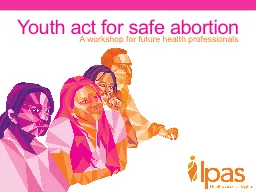

A w orkshop for future health professionals Barriers to safe abortion and strategies to address them MODULE 3 Module 3 learning objectives Describe different barriers that affect womens and adolescents access to safe abortion ID: 920238
Download Presentation The PPT/PDF document "You th act for safe abortion" is the property of its rightful owner. Permission is granted to download and print the materials on this web site for personal, non-commercial use only, and to display it on your personal computer provided you do not modify the materials and that you retain all copyright notices contained in the materials. By downloading content from our website, you accept the terms of this agreement.
Slide1
Youth act for safe abortion
A workshop for future health professionals
Slide2Barriers to safe abortion and strategies to address them
MODULE 3
Slide3Module 3 learning objectives
Describe different barriers that affect women’s and adolescents’ access to safe abortion care Identify different strategies to improve access to safe abortion care, and explain which of these strategies medical students are well-suited to implement
Slide4Module 3 activities
3.A: Understanding national abortion laws and policies 3.B-I: The quest for safe abortion, Barriers
3.B-II: The quest for safe abortion
,
Strategies
VCAT 3: The
last abortion
Total: 3 hours and 45 min
Slide5Understanding national abortion laws and policies
Activity 3.A
Slide6The quest for safe abortion, Barriers
Activity 3.B, Part I
Slide7The quest for safe abortion, Strategies
Activity 3.B, Part II
Slide8Barriers to safe abortion
Delay access to safe servicesDrive women to high-risk, unsafe abortions Delay care-seeking for complications
Force women to risk their life and health
Force women to become mothers against their will
Slide9Legal and policy barriers
Restrictive abortion laws with no or few indications for safe, legal abortionLaws that are vague
and/or in conflict with other laws, creating confusion and doubt about when abortion is legal and under what conditions
Restrictive national policies and guidelines
:
Limiting types of providers who can perform abortion
Requiring signatures by multiple providers
Mandating third-party involvement
Slide10Social and cultural barriers
Gender discrimination and violencePoverty and unequal control of financial resources
Religious institutions
that oppose safe abortion
Abortion stigma
Lack of social support
Lack of accurate information
Slide11Abortion stigma
Implies that women who seek or have abortions are inferior
Make women resort to unsafe abortion and/or hide their abortion
Can make providers unwilling to offer safe abortion
Can make providers of safe abortion feel stigmatized while they also feel proud to be saving women’s lives
Components of stigma include labeling, stereotyping and separation, and status loss.
Slide12Health systems barriers
Lack of facilities offering safe abortionLack of trained providers who are supportive of safe abortion
Low quality of care
, including lack of privacy and judgmental provider attitudes
Cost of services
Slide13Professional obligations
Inform a pregnant woman of all possible health-care options and respect her choice Clearly
state what services
the provider refuses
to provide, and refer women to
another,
nearby provider who offers those
services
When a referral
might cause delays or put
the woman’s health
or life at
risk, provide timely abortion services regardless of personal objections
Provide
life-saving postabortion care without
delay
Slide14“
We do not have access to contraception. We are stigmatized if we have a child before marriage. We do not have the right to abortion. What a dilemma! How can we not die if we are exposed to risky [unsafe] abortions? How can we not resort to abortion if a child before marriage is a sacrilege? How can we avoid having children when there are no contraceptive services?”
Young
woman, Democratic Republic of the Congo (Greene et al. 2010)
Slide15Addressing the barriers
Where to start?!...Gather reproductive health and abortion data to identify magnitude of problem and service access points
Conduct a
community assessment
to identify women’s holistic needs and recommendations for change
Partner with
local stakeholders
and support community ownership
Slide16What works in safe abortion programming
Culturally relevant and participatory approaches Gender equality promotionCommunity
and youth-generated solutions
Programs
at multiple levels (policy, community and health systems)
Slide17Strategies for medical students
Legal and
policy
Community
Health
systems
Seek to influence the legal and policy frameworks by making consensus documents and lobbying policymakers, testifying in legislative hearings and conducting media outreach
Raise community awareness of unsafe abortion and/ or existing abortion law
Sensitize community and religious leaders, and support champions for safe abortion
Train peer educators and do peer education on abortion
Run social networks that provide safe abortion accompaniment
Advocate for the inclusion of safe abortion in health sciences curricula and ensure clinical training opportunities to build capacity and commitment of future providers
Slide18Module 3 key messages
Women who seek safe abortion face a myriad of legal and policy, sociocultural, and health systems barriers
These barriers can drive women to resort to unsafe abortion and risk their lives and health
A
community
assessment of women’s
needs and
recommendations
informs program
design
Programs
that
are culturally relevant, participatory, and work at the policy
, community
and
health
systems levels have
the most positive
outcomes
Medical students can
support more
progressive laws and policies, conduct community education and engagement activities, and advocate for
safe
abortion in their curricula and clinical
practice
Slide19References
All citations and resources mentioned in this presentation are listed in the bibliography of Youth act for safe abortion, a training guide for health professionals